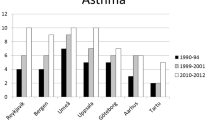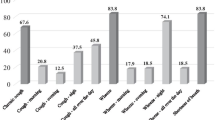Abstract
This study examined the relationship between parental smoking and asthma and other atopic diseases at the ecological level. The prevalence of atopic symptoms in 6–7- and 13–14-year old children was assessed in 91 centres (from 38 countries) and 155 centres (from 56 countries) respectively in the International Study of Asthma and Allergy in Childhood (ISAAC). These symptoms were related to prevalence of tobacco smoking for each country by gender as reported by the World Health Organisation. There was a significant negative association between the prevalence of smoking by men and the prevalence of symptoms of asthma and rhinitis, but not eczema in the 13–14-year age group. There was a significant positive relationship between prevalence of smoking by women and prevalence of wheeze in the last 12 months, but not for any other symptoms in the 13–14-year age group. In the 6–7-year age group, there was a significant negative correlation between prevalence of smoking by men and the prevalence of wheeze causing sleep disturbance and a close to significant negative association at the 5% level with the prevalence of wheeze in the last 12 months and rhinitis. Thus, for the countries that are included in this analysis, countries that have high adult male smoking rates have a lower risk of asthma and rhinitis symptoms in children. It should be stressed that this analysis does not involve information on individual exposures and therefore does not contradict the well-established association of active and passive smoking in individuals with the occurrence of asthma symptoms in the same individuals. Rather, it indicates that this well-established individual-level association does not account for the international differences in asthma prevalence, and that other risk factors for asthma must be responsible for the observed international patterns.
Similar content being viewed by others
References
ISAAC Steering Committee. Worldwide variations in the prevalence of asthma symptoms: the International Study of Asthma and Allergies in Childhood (ISAAC). Eur Respir J 1998; 12: 315–335.
Strachan D, Sibbald B, Weiland S, et al. Worldwide variations in prevalence of symptoms of allergic rhinoconjunctivitis in children: the International Study of Asthma and Allergies in Childhood (ISAAC). Pediatric Allergy Immunol 1997; 8: 161–176.
Beasley R, Keil U, von Mutius E, et al. World-wide variation in prevalence of symptoms of asthma, allergic rhinoconjunctivitis, and atopic eczema: ISAAC. Lancet 1998; 351: 1225–1232.
Williams HC, Robertson CF, Stewart AW, et al. Worldwide variations in the prevalence of atopic eczema in children from the international study of asthma and allergies in childhood (ISAAC). J Allergy Clin Immunol 1999; 103: 125–138.
Magnus P, Jaakkola JJ. Secular trend in the occurrence of asthma among children and young adults: Critical appraisal of repeated cross sectional surveys. Brit Med J 1997; 314: 1795–1799.
Mitchell EA. Asthma epidemiology: Clues and puzzles. Pediatr Pulmonol 1999; 18 (Suppl): 31–33.
World Health Organization. Tobacco or health: A global status report. Geneva: WHO, 1997.
Cook DG, Strachan DP. Efects of maternal and paternal smoking on children's respiratory health. In: WHO, Tobacco Free Initiative (eds), International Consultation on Environmental Tobacco Smoke (ETS) and Child Health. Geneva: World Health Organisation, 1999: 31–59.
World Bank. World Development Report, 1995. Oxford; Oxford University Press.
Stewart AW, Mitchell EA, Pearce N, Strachan DP, Weiland SK. The relationship of per capita gross national product to the prevalence of symptoms of asthma and other atopic diseases in children: The International Study of Asthma and Allergies in Childhood (ISAAC). Int J Epidemiol 2001; 30: 173–179.
Breslow NE, Clayton DC. Approximate inference in generalized linear mixed models. J Amer Statist Assoc 1993; 88: 9–25.
Wolfinger R, O'Connell M. Generalized linear mixed models: A pseudo-likelihood approach. J Statist Comp Simulation 1993; 48: 233–243.
Greenland S, Morgenstern H. Ecological bias, confounding, and effect modification. Int J Epidemiol 1989; 18: 269–274.
Martinez FD, Holt PG. Role of microbial burden in aetiology of allergy and asthma. Lancet 1999; 354(Suppl 2): SII12–SII15.
Strachan DP. Family size, infection and atopy: The first decade of the 'hygiene hypothesis'. Thorax 2000; 55(Suppl 1): S2–S10.
Holberg CJ, Wright AL, Martinez FD, Morgan WJ, Taussig LM. Child day care, smoking by caregivers, and lower respiratory tract illness in the first 3 years of life. GroupHealth Medical Associates. Pediatrics 1993; 91: 885–892.
Weiland SK, von Mutius E, Hirsch T, et al. Prevalence of respiratory and atopic disorders among children in the East and West of Germany five years after unification. Euro Respirat J 1999; 14: 862–870.
Bakke P, Gulsvik A, Eide GE. Hay fever, eczema and urticaria in southwest Norway. Lifetime prevalences and association with sex, age, smoking habits, occupational airborne exposures and respiratory symptoms. Allergy 1990; 45: 515–522.
Burr ML, Anderson HR, Austin JB, et al. Respiratory symptoms and home environment in children: A national survey [published erratum appears in Thorax 1999; 54: 376]. Thorax 1999; 54: 27–32.
Min YG, Jung HW, Kim HS, Park SK, Yoo KY. Prevalence and risk factors for perennial allergic rhinitis in Korea: Results of a nationwide survey. Clin Otolaryngol Allied Sci 1997; 22: 139–144.
Siracusa A, Marabini A, Sensi L, et al. Prevalence of asthma and rhinitis in Perugia, Italy. Monaldi Arch Chest Dis 1997; 52: 434–439.
Cook DG, Whincup PH, Jarvis MJ, Strachan DP, Papacosta O, Bryant A. Passive exposure to tobacco smoke in children aged 5–7 years: Individual, family, and community factors. Brit Med J 1994; 308: 384–389.
Astone NM, Alexander C, Joffe A, Kanarek N. The social and demographic correlates of smoking among young adults in Maryland. Am J Preventive Med 1997; 13(Suppl 6): 25–29.
Butland BK, Strachan DP, Anderson HR. Fresh fruit intake and asthma symptoms in young British adults: Confounding or effect modification by smoking? Euro Respir J 1999; 13: 744–749.
Author information
Authors and Affiliations
Rights and permissions
About this article
Cite this article
Mitchell, E., Stewart, A. The ecological relationship of tobacco smoking to the prevalence of symptoms of asthma and other atopic diseases in children: The International Study of Asthma and Allergies in Childhood (ISAAC). Eur J Epidemiol 17, 667–673 (2001). https://doi.org/10.1023/A:1015500508261
Issue Date:
DOI: https://doi.org/10.1023/A:1015500508261




